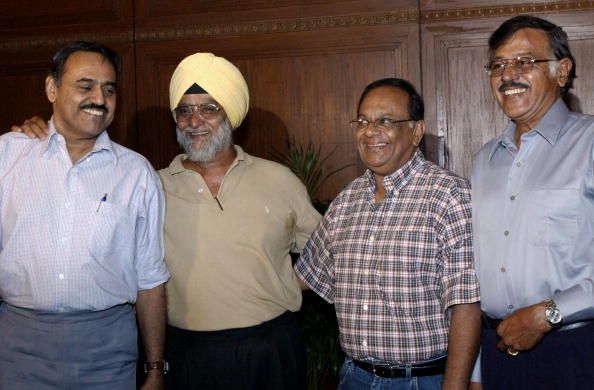
Moments that changed cricket forever: Mystery spinners - bamboozling to greatness
There is a certain mystique in the art of spin bowling; at first glance, it bamboozles the mind and the eyes so much so that the batsman is often caught in a quandary resembling the age-old chicken-and-egg dilemma. Before he has time to register where the rapidly rotating ball is going to land, he has already played a “nothing” shot or offered no stroke, thus losing his wicket. He walks back shaking his head in bewilderment, utterly at a loss to even fathom his downfall.

Indian spin bowlers Bhagwat Chandrasekhar (L), Bishen Singh Bedi (2nd from L), Erapalli Prasanna (third from left) and Srinivas Venkatraghavan (R) pose in Calcutta 30 May 2003. The Board of Control for Cricket in India (BCCI) organised a meeting of the spin bowlers of past and present. (ADESHAKALYAN CHOWDHURY/AFP/Getty Images)
Such has been the success of slow bowling – I do not consider the gentle medium pacers as being in the same category – that teams around the world have made exponents of this art a mandatory presence in the playing eleven. The use of such bowlers has pioneered many innovations: New Zealand’s Martin Crowe utilized the services of Dipak Patel to open the bowling in the 1992 World Cup, for example – a trend that was replicated a few times in the following years, and very recently in the Indian Premier League.
The technique of bowling spin has developed into different categories – the conventional off-spin (where the ball turns into a right-handed batsman and goes away from the left-hander) was a precursor to the others. Laker, Mallett, Venkatraghavan, Prasanna, Muralitharan, Ajmal and Swann – all have been pioneers in adding new dimensions to what is considered as the oldest form of spin.
Leg-spin and left-arm spin followed, blessing the game of cricket with its luminaries in the form of Bill O’Reilly, Jenner, Tony Lock, Bedi, Chandrasekhar, Dipak Patel, Warne, Kumble, Vettori and many others. Cricket is all the richer for them.
The genesis of suspense lies in the declining years of the nineteenth century and the early days of the twentieth. The first signs of ‘mystery’ bowling were evident in the way Englishman Bernard Bosanquet developed the googly – which appeared to be a conventional leg-break, but after pitching, the ball turned in the opposite direction to which it was expected, behaving like an off-break. He fashioned this delivery while playing a table-top game at Oxford, honing it to perfection and using it to trouble opposing batsmen during his Test debut against Australia in 1903. Incidentally, he started his cricketing career as a pace bowler before switching to spin.
It became a stock ball for the leg-break bowlers; an important weapon in their arsenal. Australians Bill O’Reilly, Clarrie Grimmett, Terry Jenner and Shane Warne would often use it to fox batsmen around the world. Grimmett developed the flipper - the ball would be deceptively low after pitching – and thus added to the mystery. Both Warne and Kumble used this delivery to great success.
However, the earliest ‘mystery spinner’ is widely believed to be Victoria’s Jack Iverson, who would grip the ball with his thumb and middle finger, producing a peculiar type of spin. This unorthodox grip allowed him to bowl a mixture of off-breaks, googlies and leg-breaks while exhibiting no discernible change of action. The New Zealand batsmen in 1950-51 were all at sea when playing Iverson – he ended up dismissing 75 batsmen at seven runs each, and grabbed 6/27 against the visiting English in 1951. Jack’s method was eventually figured out by batsmen, and after an ankle injury, he never played cricket again.
Over the years, more mystery bowlers flourished in the art of spin – Jack Potter brought in a delivery similar to the doosra into the game during the 1964 Ashes tour, prompting Richie Benaud to say: “If I had a ball like that, I’d be practising at Lord’s before breakfast.”